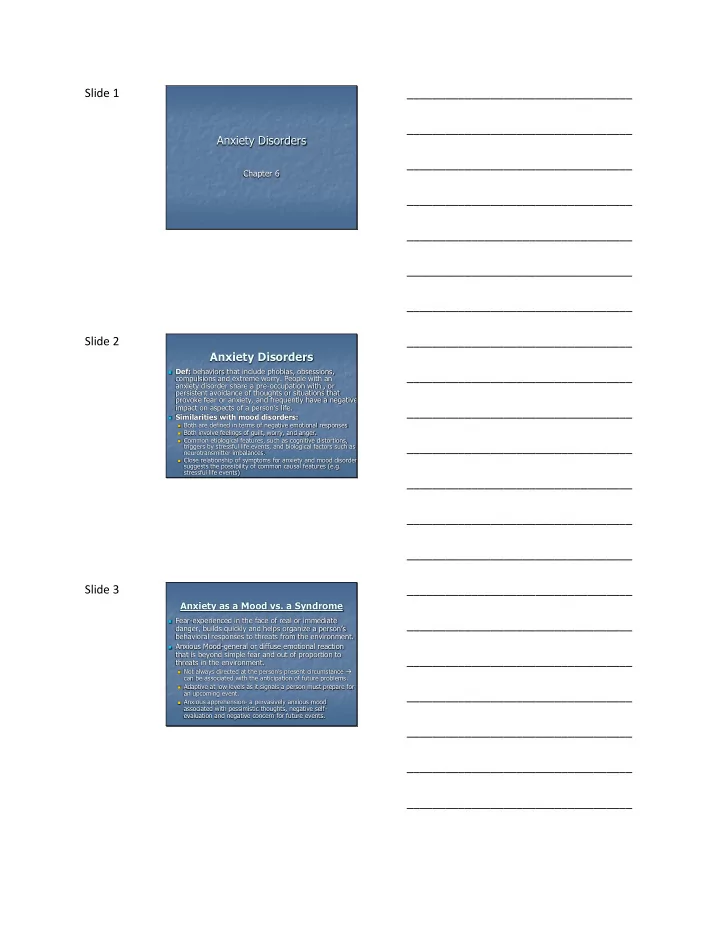

Slide 1 ___________________________________ ___________________________________ Anxiety Disorders ___________________________________ Chapter 6 ___________________________________ ___________________________________ ___________________________________ ___________________________________ Slide 2 ___________________________________ Anxiety Disorders Def: behaviors that include phobias, obsessions, ___________________________________ compulsions and extreme worry. People with an anxiety disorder share a pre-occupation with , or persistent avoidance of thoughts or situations that provoke fear or anxiety, and frequently have a negative impact on aspects of a person’s life. ___________________________________ Similarities with mood disorders: Both are defined in terms of negative emotional responses Both involve feelings of guilt, worry, and anger. Common etiological features, such as cognitive distortions, ___________________________________ triggers by stressful life events, and biological factors such as neurotransmitter imbalances. Close relationship of symptoms for anxiety and mood disorder suggests the possibility of common causal features (e.g. stressful life events) ___________________________________ ___________________________________ ___________________________________ Slide 3 ___________________________________ Anxiety as a Mood vs. a Syndrome Fear-experienced in the face of real or immediate ___________________________________ danger, builds quickly and helps organize a person’s behavioral responses to threats from the environment. Anxious Mood-general or diffuse emotional reaction that is beyond simple fear and out of proportion to ___________________________________ threats in the environment. Not always directed at the person’s present circumstance can be associated with the anticipation of future problems. Adaptive at low levels as it signals a person must prepare for an upcoming event. ___________________________________ Anxious apprehension- a pervasively anxious mood associated with pessimistic thoughts, negative self- evaluation and negative concern for future events. ___________________________________ ___________________________________ ___________________________________
Slide 4 ___________________________________ Symptoms of Anxiety Disorders Excessive Worry- ___________________________________ Panic Attacks - Phobias- persistent, irrational narrowly defined fears that are associated with a specific object or situation. Obsessions and Compulsions ___________________________________ Obsessions (def)-repetitive unwanted, intrusive cognitive events that may take the form of thoughts images or impulses and lead to an increase in subjective anxiety. Compulsions-repetitive behaviors or mental acts that are used to reduce anxiety. ___________________________________ ___________________________________ ___________________________________ ___________________________________ Slide 5 ___________________________________ Excessive Worry ___________________________________ Cognitive activity associated with anxiety that manifests as a relatively uncontrollable sequence of negative, emotional thoughts that are concerned ___________________________________ with possible future threats or dangers. Lack of perceived control Negative Affect ___________________________________ Quantity ___________________________________ ___________________________________ ___________________________________ Slide 6 ___________________________________ Panic Attacks Panic attacks- sudden overwhelming experience of terror or fright. More focused than anxiety believed to be a normal fear response triggered at an ___________________________________ inappropriate time. Physical sensations of which the patient must experience at least four, which develop suddenly and reach peak intensity within 10 minutes: Heart palpitations Sweating Trembling or shaking ___________________________________ Sensation of shortness of breath Choking feeling Chest pain Nausea or abdominal distress Dizziness Feelings of unreality or detachment from oneself Fear of losing control or going crazy ___________________________________ Fear of dying Numbness or tingling sensation Chills or hot flushes ___________________________________ ___________________________________ ___________________________________
Slide 7 ___________________________________ Phobias ___________________________________ Persistent, irrational narrowly defined fears that are associated with a specific object or situation. Avoidance ___________________________________ Agoraphobia-Fear becomes more intense as the distance between the person and his or her familiar surroundings increases, or as avenues of escape are closed off. ___________________________________ ___________________________________ ___________________________________ ___________________________________ Slide 8 ___________________________________ Obsessions and Compulsions Obsessions and Compulsions- ___________________________________ Obsessions (def)-repetitive unwanted, intrusive cognitive events that may take the form of thoughts images or impulses and lead to an increase in subjective anxiety. Compulsions -repetitive behaviors or mental acts that are used to reduce anxiety. ___________________________________ Obsessions Seem to come out of the blue Content of obsessions Compulsions-Must perform the ritual to keep something “bad” from happening . ___________________________________ Most common are cleaning and checking ___________________________________ ___________________________________ ___________________________________ Slide 9 ___________________________________ Diagnostic Systems of Anxiety Disorders (DSM-IV-TR) Panic Disorder ___________________________________ Recurrent unexpected panic attacks with at least half of the attacks followed by a period of one month or more in which the person fears having another attack. (fear of fear) Avoidance of the situation (change in behavior) Agoraphobia ___________________________________ Avoid the situation or endure it with great distress Insist on being accompanied by a safe person. Specific Phobia-marked and persistent fear that is excessive or unreasonable, cued by the presence of specific object or situation. ___________________________________ Exposure produces immediate fear response Awareness that fear is unreasonable Avoidance ___________________________________ ___________________________________ ___________________________________
Recommend
More recommend